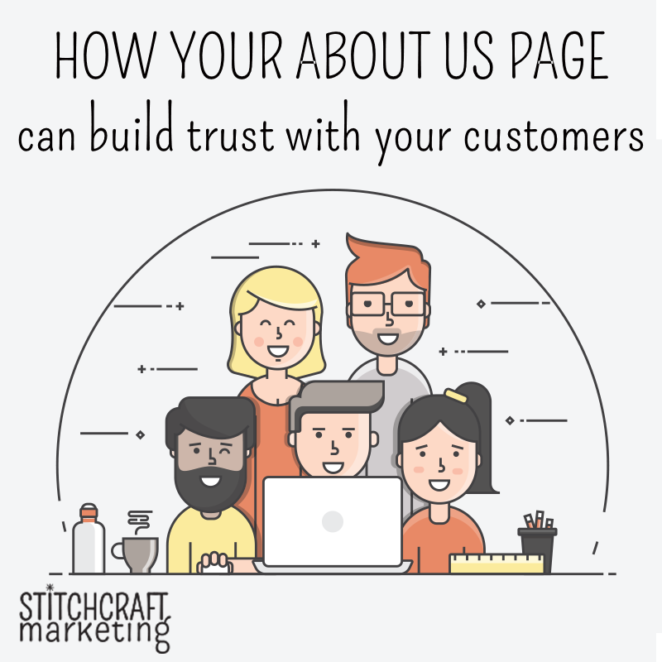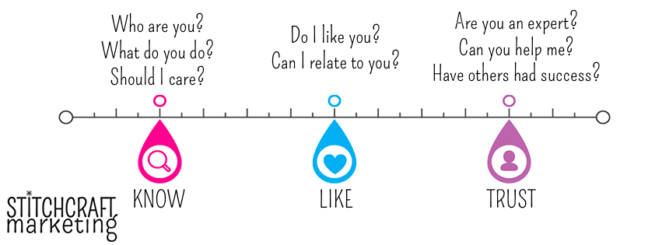03 May Best Practices for “About Us” Pages
 Have you looked at any “About Us” pages on company websites lately? We have, and what we are seeing hasn’t impressed us. An “About Us’ page is an essential part of your company’s branding. It’s how you present your company’s story and people behind it. It may not be the first place potential retail customers land, but it is the place where potential retail partners learn about your company and decide whether they want to contact you for further information. We’re going to offer the basic elements an “About Us’ page should include so that you have a template for designing your own or upgrading the one currently on your website.
Have you looked at any “About Us” pages on company websites lately? We have, and what we are seeing hasn’t impressed us. An “About Us’ page is an essential part of your company’s branding. It’s how you present your company’s story and people behind it. It may not be the first place potential retail customers land, but it is the place where potential retail partners learn about your company and decide whether they want to contact you for further information. We’re going to offer the basic elements an “About Us’ page should include so that you have a template for designing your own or upgrading the one currently on your website.
Let’s start by understanding why your “about us” page has so much value for your consumer with a brief lesson on what we call the Know-Like-Trust Funnel:
Understand the Know-Like-Trust Funnel of purchasing behavior
When a potential customer is deciding whether or not to purchase something, many times, they move through a series of unconscious questions to gather information about you and your company in an effort to determine whether or not they “trust” you enough to buy from you.
The first contact with a company generally begins with the first stage of the funnel, “KNOW”. This is where the consumer is gathering information to move them to the “LIKE” part of the funnel and eventually to the “TRUST” phase where most conversions happen. Your job as a retailer is to help them move quickly and confidently through these phases and feel good about their purchase with you. Your “About Us” page is an excellent, and yet, woefully underutilized tool to convey this information. Give your visitors the answers to the questions on this page and they will easily get to know you, like you, and trust you and your brand. Let’s walk through each of the different places where you can take advantage of this opportunity:
Names
Who is your founder or owner, the key person in your company? That name, first and last, belongs on your About Us page. For example, if you visit www.cestarisheep.com and click on the “About” tab, it is abundantly clear that this yarn company is Francis Chester-Cestari’s life’s work. While his daughter Sabrina Chester is the shearer for the farm, and is pictured in the family photo on the About page, her part of the story is contained in the videos on the Home page. The About page focuses on Francis, because the farm, the mill and the story of American-grown, raised and processed yarn is the story of Cestari Sheep and Wool and the story of Francis Chester-Cestari’s life. Now they know who you are.
Your Story
Your About page is the place to tell the world what your company does, how you do it and why you feel compelled to do it. Here you can share your values and your vision and make connections with your customers.
How you tell your story is important. Words matter, but so do images, and the right combination of the two draws the reader into your company’s story and makes them want to be a part of it. June Cashmere’s Who We Are page is a perfect example of effective storytelling. Without reading a word, a visitor to the page understands that their cashmere yarn is a heritage product from a very specific region of the world. The words, however, flesh out the story told in the pictures so that we learn how this business creates economic opportunity in Kyrgyzstan and gives back to the local communities of nomadic shepherds whose animals produce the fiber. It is a clear and uncluttered page, focused on the origin and development of this unique company. The nuts-and-bolts information of Contact, Search, and social media sites are at the bottom of each page of the website, rather than having a page of their own. Organizing information in this way highlights the Who and the Why of June Cashmere’s story, compelling the reader to scroll to the bottom of the page, where they find all the other information they might need. The design of the page lets the story be the star. It’s hard not to Like June Cashmere.
Your Values
Both examples cited here deliver an unmistakable message about the specific company’s values. Cestari Sheep and Wool uses video effectively, letting Francis Chester-Cestari tell his story in his own voice. It’s a page heavy on images and fairly light on text, but the viewer/reader comes away with an impression of authenticity and a commitment to small American farms. June Cashmere’s story involves text and images in a balance, like a beautiful photographic storybook, showing a rugged land in contrast with a delicate fiber and convincing the reader that buying this yarn will make a difference in the lives of the herders who gather and grade it.
What does your company value? Tell your story in such a way that a visitor to your About page can answer that question. The sincerity of the way your story conveys your values creates Trust for your customers.
An Invitation
Now your About page tells an engaging story through images and text. Your customers Know, Like and Trust you. How do you keep that page visitor engaged? End the page with some kind of a call to action, whether it’s a feedback form, a newsletter sign-up, or an invitation to follow your company on social media sites. You want something on the page that converts the momentary engagement into an ongoing relationship. Let the visitors imagine themselves as part of your company’s story and offer them a way to connect.
What Not to Do
You don’t have to put all the practical information on your About page; to deliver a clear message about your brand’s history and identity, you may want to establish separate tabs or footers on your website pages for Contact, Shop, Directions or other information. Wherever you put Contacts, make sure the information is complete. A retailer who is interested in carrying your products in my store needs to know exactly whom to contact.. You can make it easier for the information-seeker by stating exactly which person is in charge of which function: For Wholesale Inquiries; For Donations; For Employment, or other categories you find necessary. Pictures of each staff member are a nice addition, but resist the temptation to be casual and friendly by labeling them only with first names. It’s better to have full contact information without pictures than incomplete information with them.
Make sure the design of your About page is fresh and modern. We don’t want to pick on any particular company, but a visit to the About pages of some major US commercial yarn companies show text-heavy pages with layouts that we’re pretty sure were Tables created in Netscape Navigator 20 years ago. Slapping a product picture next to a bunch of words doesn’t invite the reader into your story. Good design goes a long way in telling a memorable story.
Finally, share your dreams. Your company’s history is great, but it’s not the only thing to include in your story. Incorporate the vision of where your company is headed, not just where it’s been
Your About page establishes your company’s personality and you want it to be dynamic, not static. Contact outreach@stitchcraftmarketing.com. We can help you with both content and design to bring your brand’s personality to life.



No Comments